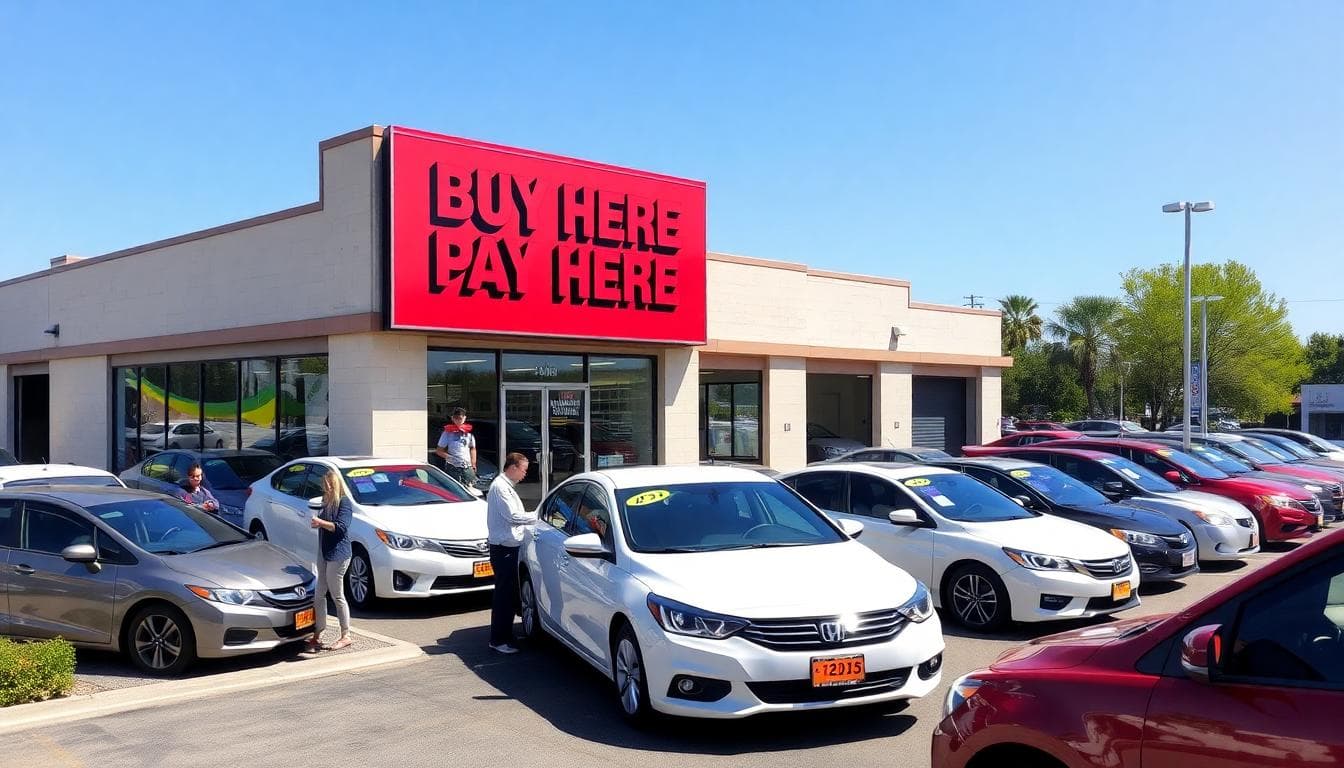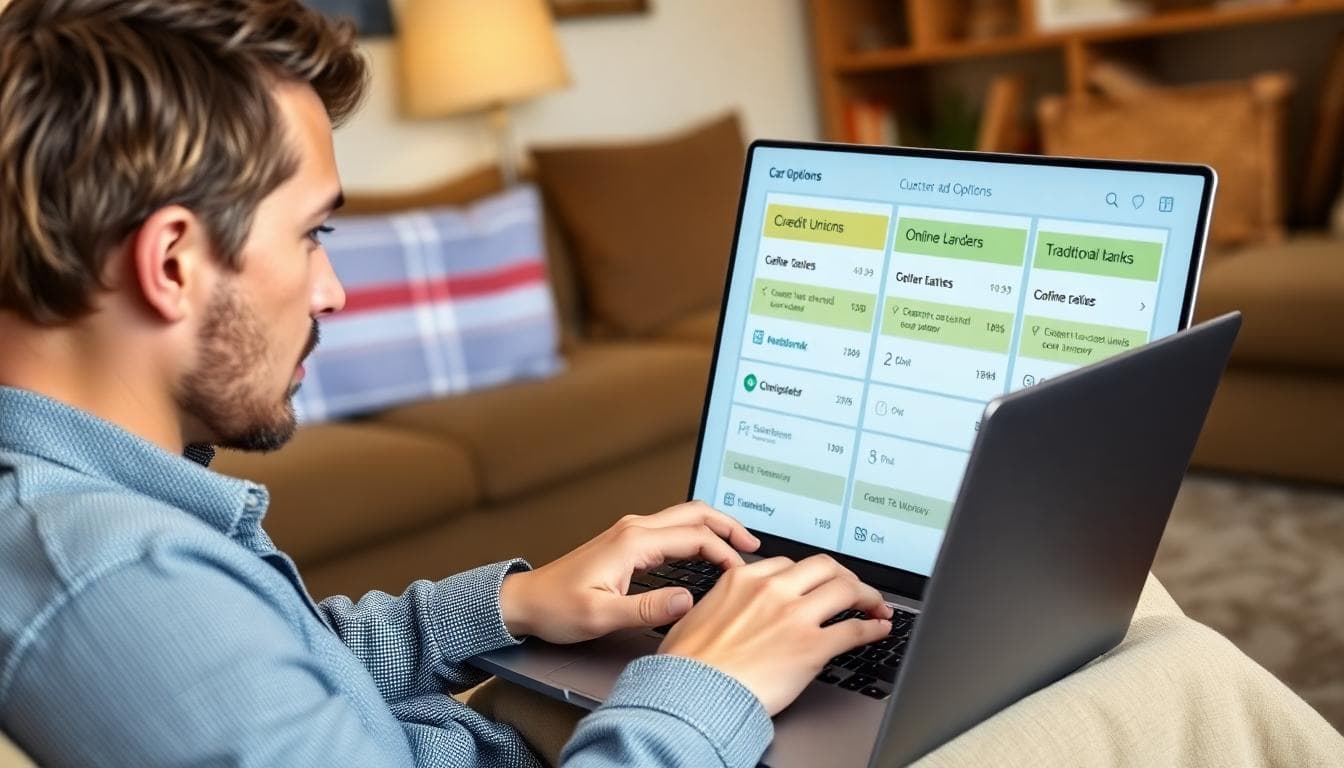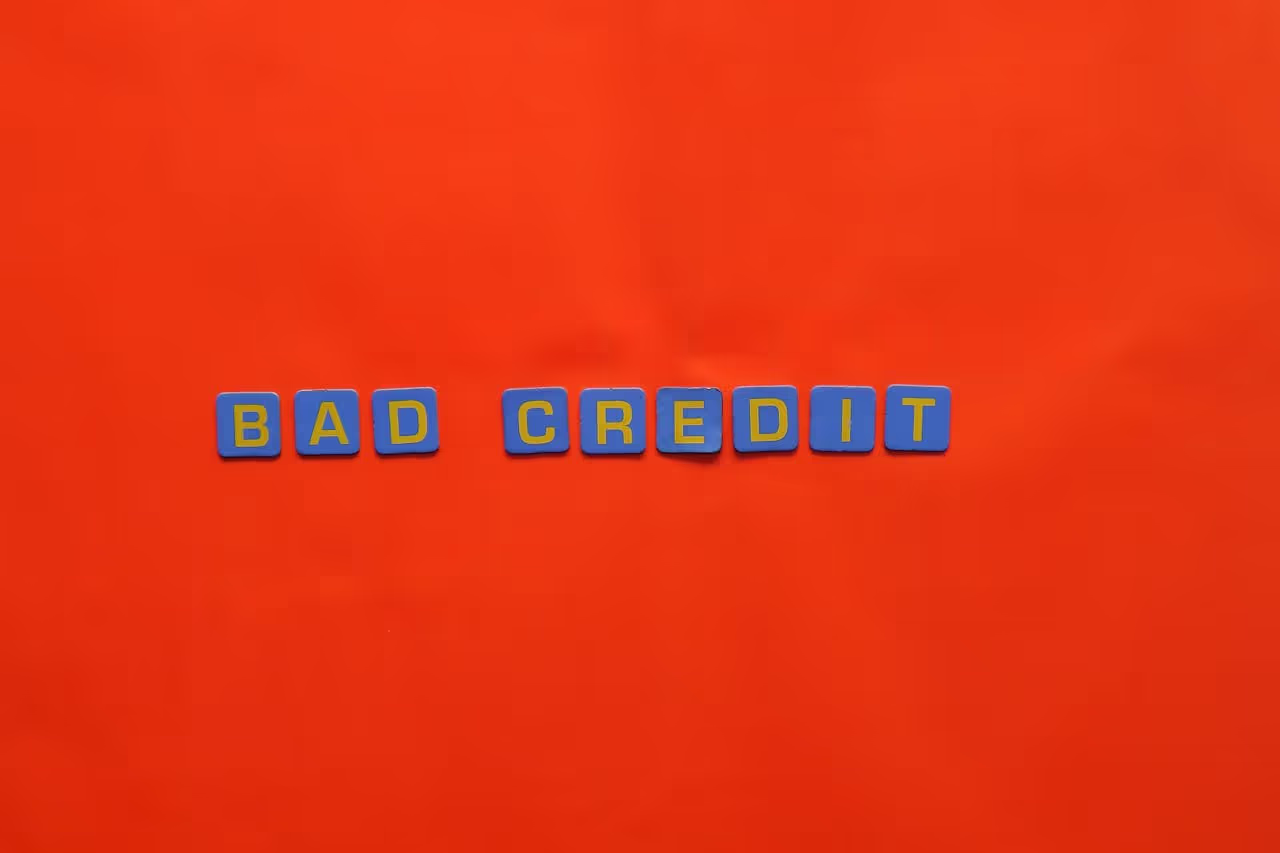Buy Here Pay Here Dealerships: 2025 Guide (Pros and Cons)
Need a car this week, but your credit score is a mess? You’re not alone. With used car prices still running high in 2025 and banks tightening standards, many buyers are turning to buy here pay here dealerships to get on the road fast.
Here’s the quick picture. A buy here pay here dealer sells you the car and finances it in-house, no bank required. Approval is usually simple, proof of income and a down payment. Payments are often weekly or biweekly, and some dealers report to the credit bureaus, which can help you rebuild credit.
But speed has a price. Typical BHPH interest rates land around 18 to 25 percent or more, while average used car rates from traditional lenders hover closer to the low teens. Cars can be older, you might face GPS tracking, and missed payments can trigger quick repossession. That’s why this guide matters right now, it shows you how to weigh the trade-offs in a tough market.
In this complete guide, you’ll learn what BHPH financing is, how it differs from dealer loans through banks, and what rates to expect. You’ll see clear pros like fast approval and possible credit building, and the cons like high costs, strict terms, and added risks. We’ll flag warning signs of predatory BHPH dealers, share safer alternatives, and map out when BHPH actually makes sense.
If you need a reliable ride, can’t clear a bank’s hurdle, and must buy soon, BHPH might be a bridge, not a destination. Use this guide to protect your wallet, choose smarter loan terms, and decide if a BHPH lot is the right move for you in 2025.
What Are Buy Here Pay Here Dealerships and How Do They Work?
Buy here pay here dealerships sell the car and finance it in-house. You submit a loan application on the lot, not with a bank. Approval often depends on your income, residence, and down payment. Payments are usually weekly or biweekly, and the dealer collects them directly. Many buyers choose BHPH when credit is thin or past-due accounts limit options.
Here is the core idea. The dealer acts as the lender, sets the rate, and keeps the loan. That can move fast. It can also cost more. Rates often land around 18 to 25 percent or higher. Vehicles can be older with higher miles. Some lots install GPS trackers or starter-interrupt devices to manage risk. Read every page of the contract. Ask about total cost, late fees, and the repossession policy before you sign. For a quick overview of how this process looks on a typical lot, skim this helpful buy here pay here basics guide.
 Exterior of a buy here pay here lot with shoppers and inventory. Image created with AI.
Exterior of a buy here pay here lot with shoppers and inventory. Image created with AI.
Key Steps in the BHPH Buying Process
The flow is simple, and it usually happens in a single visit. Use this checklist so you know what to expect and what to ask.
Visit the lot and scan inventory
- Walk the lot, sit in a few cars, and ask about price, miles, and any reconditioning. You can often test drive on a short route.
- Inventory ties to financing. Some cars may require larger down payments based on risk.
- Example: You like a 2016 sedan at $12,500. The salesperson explains that car needs $2,500 down because of its lower miles.
Walk the lot, sit in a few cars, and ask about price, miles, and any reconditioning. You can often test drive on a short route.
Inventory ties to financing. Some cars may require larger down payments based on risk.
Example: You like a 2016 sedan at $12,500. The salesperson explains that car needs $2,500 down because of its lower miles.
Pick a car and check the basics
- Ask for a vehicle history report if available, and request service records. Some dealers will share inspection sheets.
- Look for warning lights, uneven tire wear, or leaks during the test drive.
- Tip: Bring a simple checklist. If the A/C is weak or brakes squeal, note it and negotiate.
Ask for a vehicle history report if available, and request service records. Some dealers will share inspection sheets.
Look for warning lights, uneven tire wear, or leaks during the test drive.
Tip: Bring a simple checklist. If the A/C is weak or brakes squeal, note it and negotiate.
Provide proof of income and residency
- Bring recent pay stubs, bank statements if you are gig or self-employed, a utility bill for address, and a valid ID.
- Dealers use income and credit history, not just credit score, to size your loan and payment.
- Example: You show $3,200 monthly take-home pay. The dealer targets a weekly payment around 10 percent of that, spread out, to fit their policy.
Bring recent pay stubs, bank statements if you are gig or self-employed, a utility bill for address, and a valid ID.
Dealers use income and credit history, not just credit score, to size your loan and payment.
Example: You show $3,200 monthly take-home pay. The dealer targets a weekly payment around 10 percent of that, spread out, to fit their policy.
Get approved for an in-house loan
- The dealer runs your info and approves you on the spot in many cases. Terms vary by car, down payment, and risk profile.
- Expect higher interest and shorter terms than a bank loan. Many lots set weekly or biweekly payments to match your paycheck.
- For a step-by-step view of how some lots structure this, see this quick overview of BHPH steps.
The dealer runs your info and approves you on the spot in many cases. Terms vary by car, down payment, and risk profile.
Expect higher interest and shorter terms than a bank loan. Many lots set weekly or biweekly payments to match your paycheck.
For a step-by-step view of how some lots structure this, see this quick overview of BHPH steps.
Review the contract and payment schedule
- Read every line. Confirm the APR, total of payments, late fees, grace periods, and whether payments are weekly, biweekly, or monthly.
- Ask if the dealer reports to the credit bureaus. Reporting can help you build credit if you pay on time.
- Verify required insurance. Many BHPH lots require full coverage for the life of the loan.
Read every line. Confirm the APR, total of payments, late fees, grace periods, and whether payments are weekly, biweekly, or monthly.
Ask if the dealer reports to the credit bureaus. Reporting can help you build credit if you pay on time.
Verify required insurance. Many BHPH lots require full coverage for the life of the loan.
Expect a GPS tracker or starter device on the car
- Many BHPH dealers install a GPS tracker. Some use a starter-interrupt device if payments fall behind.
- This helps them locate the car for recovery. It also means missed payments can trigger fast action.
- Ask how the device works, what data it collects, and what happens if there is a mistake.
Many BHPH dealers install a GPS tracker. Some use a starter-interrupt device if payments fall behind.
This helps them locate the car for recovery. It also means missed payments can trigger fast action.
Ask how the device works, what data it collects, and what happens if there is a mistake.
Sign, make the first payment, and drive off
- Many lots require your first payment before you leave, plus the down payment and fees.
- You will get details on how to pay. Common options include cash at the window, debit card, money order, an app, or a payment kiosk.
- Example: You pay $2,000 down and your first weekly payment of $115, then schedule auto-pay to avoid late fees.
Many lots require your first payment before you leave, plus the down payment and fees.
You will get details on how to pay. Common options include cash at the window, debit card, money order, an app, or a payment kiosk.
Example: You pay $2,000 down and your first weekly payment of $115, then schedule auto-pay to avoid late fees.
Keep up with payments and communication
- Pay on or before the due date, every time. Late fees add up fast.
- If something changes, call ahead. Some lots offer short grace periods or a one-time payment deferral.
- Save texts, receipts, and any promises in writing.
Pay on or before the due date, every time. Late fees add up fast.
If something changes, call ahead. Some lots offer short grace periods or a one-time payment deferral.
Save texts, receipts, and any promises in writing.
What to double-check before you sign:
Total cost: Price, APR, term, and total of payments.
Vehicle condition: Any warranty, service contract, or return policy.
Fees: Late fees, repossession fees, GPS device charges, documentation fees.
Payment rules: Due dates, grace period, accepted methods, and where to pay.
Credit reporting: Whether they report on-time and late payments.
 Customer signing an in-house auto loan at a BHPH desk. Image generated by AI.
Customer signing an in-house auto loan at a BHPH desk. Image generated by AI.
Quick example to bring it together:
You choose a $10,500 car with $2,000 down. The dealer approves you at 23 percent APR over 30 months, with $120 weekly payments. The contract lists a GPS device and a $35 late fee after a 3-day grace period. You set auto-pay, confirm they report to one bureau, and keep full coverage insurance. You leave the lot the same day with keys and a clear plan.
Key takeaway: buy here pay here dealerships can put you in a car fast, but the contract drives everything. Slow down, read it all, and only sign terms you can live with week after week.
How Buy Here Pay Here Financing Differs from Traditional Dealer Loans
Buy here pay here dealerships finance you in-house, set their own terms, and collect payments directly. Traditional dealer loans rely on banks or credit unions, which means stricter approvals but usually lower costs. If you need a car now and your credit is weak, BHPH can feel like a shortcut. The trade-off is price, rules, and risk.
 Visual contrast between BHPH and traditional dealer financing settings. Image created with AI.
Visual contrast between BHPH and traditional dealer financing settings. Image created with AI.
Interest Rates and Hidden Costs in BHPH Deals
BHPH loans usually carry high APRs to offset risk. In 2025, it is common to see 18 to 25 percent APR, sometimes higher for tougher files. Traditional used car loans trend far lower. Experian’s first quarter 2025 data puts the average used rate around 11.87 percent for bank and credit union lenders, with top-tier borrowers often much lower. See the current breakdown in this Experian overview of used car loan interest rates for 2025. For context on top credit tiers, recent reporting shows super-prime borrowers near 5 percent on new loans, which helps show the gap between high-credit bank pricing and BHPH offers. You can scan a current snapshot in U.S. News’ auto loan rates update.
Here is what makes BHPH costs add up fast, especially with high interest rates:
High APRs: 18 to 25 percent is common, 29 percent is not rare for risky files.
Payment cadence: Weekly or biweekly payments feel smaller, but they can increase the chance of late fees.
Fees: Late fees, payment processing fees, GPS or starter-interrupt device fees, repo fees, and sometimes rekeying or storage charges.
A quick comparison helps you weigh the differences at a glance.
FeatureBHPH FinancingTraditional Dealer LoanTypical APR in 202518 to 25 percent, sometimes 30 percentAbout 6 to 12 percent for many used loans; top-tier can be lowerPayment frequencyOften weekly or biweeklyMonthlyCommon add-onsGPS or starter device, higher late feesStandard late fees, fewer device add-onsApproval speedVery fast, credit-lightFast, but with a full credit review
Two simple examples show how the total cost shifts:
Example 1, BHPH: $10,500 car, $2,000 down, 23 percent APR, 30 months, weekly payments. The weekly schedule spreads charges, but interest accrues at a steep rate. One missed week can trigger a late fee within days.
Example 2, Bank or credit union: $10,500 car, $2,000 down, 10.5 percent APR, 36 months, monthly payment. The payment is larger per installment, but the interest rate cuts total interest paid.
What should you do before signing with buy here pay here dealerships?
Calculate the total of payments: Price plus interest plus fees. Ask for the total number and compare offers to a bank quote.
Check the fee stack: Late fee amount, grace period, repo fee schedule, device fee, and any payment processing charges.
Match payment timing to your paycheck: Weekly can work if you are disciplined. If not, one slip can spiral.
Stress-test the payment: Could you still pay if hours drop or a bill pops up?
Helpful rule of thumb:
If the BHPH APR is above 25 percent and the term is under 36 months, the weekly payment can look reasonable, but the total interest may exceed what you would pay on a traditional loan by thousands.
Bottom line, the difference is not just the APR, it is the loan terms. High rates, short terms, frequent payments, and layered fees change the math. Run the total cost both ways. If a bank or credit union offer is even close, it will almost always cost less than a comparable BHPH deal.
Alternatives to Buy Here Pay Here and When BHPH Makes Sense
You have options beyond buy here pay here dealerships, even with bruised credit. The goal is simple, lower the total cost, keep payments steady, and reduce the chance of a fast repo. Use this section to stack your choices, then decide when BHPH is the right tool for a short-term fix.
 Comparing auto loan options at home to avoid higher-cost financing. Image created with AI.
Comparing auto loan options at home to avoid higher-cost financing. Image created with AI.
Smarter Alternatives to Consider First
Shop around to start with the lowest-cost path you can qualify for. Even one or two points off the APR can save you a lot over the life of the loan.
Credit unions: Local credit unions are often more flexible with thin or damaged credit. Many use manual underwriting and look at your income and credit history, not only your score. Approval can be fast with direct deposit. If you can join, you can usually apply the same day.
Subprime lenders through reputable marketplaces: Some online platforms let you compare real offers without visiting a lot first. A good roundup of current options is this list of bad credit car loans in 2025. You can prequalify, see rate ranges, and avoid pressure on the lot.
Bank or captive financing with a co-signer: A strong co-signer can drop your rate, extend your term, and open better inventory. This setup can cost less than buy here pay here dealerships even if your score is low.
Traditional dealer financing with preapproval: Walk in with a credit union or bank preapproval. Dealers can try to beat it. Preapproval sets your budget and keeps monthly payment games in check. You can compare how dealer rates stack up against options in this guide to skipping BHPH lots.
Temporary car plus refinance plan: Buy a lower-priced, reliable car now, then refinance in 6 to 12 months after on-time payments. Many bad-credit lenders allow refinancing once your credit and payment history improve. A monthly payment you can sustain beats a newer car with weekly surprises.
Save a bigger down payment: Another few weeks of savings can lower the amount financed and improve your approval odds elsewhere. A larger down payment reduces risk for the lender, which can mean a lower rate.
Cash purchase with a mechanic check: If you have the flexibility, a paid-off car kills interest costs. Always get a pre-purchase inspection to avoid trading APR for repair bills.
Quick Comparison of Alternatives
Use this snapshot to line up fit, cost, and speed. For those seeking a bad credit auto loan, these options often provide better terms than high-interest dealer financing.
OptionBest forTypical AdvantagesWatch-outsCredit union loanFair to poor creditLower rates, friendly underwritingMembership needed, income verificationOnline subprime marketplaceCredit rebuild or thin filesMultiple offers, soft pulls for prequalWide rate ranges, read lender reviewsCo-signer loanLow scores with strong co-signerLower APR, better car choicesCo-signer is on the hookPreapproved bank/dealer financingBudget controlClear ceiling, dealer may beat rateRequires time for quotesCash carLowest total costNo interest, simpler ownershipOlder cars, inspection is keyRefinance planBridge to lower ratePayment drop later, credit gainsRefinance not guaranteed
For a plain-language breakdown of how BHPH differs from bank and dealer routes, this overview of BHPH dealers vs. traditional dealerships can help set expectations before you shop.
When Buy Here Pay Here Makes Sense
Sometimes you need the keys this week and every bank has said no. In that case, BHPH can be a tool for the high risk borrower. Use it on your terms, not the dealer’s.
BHPH is most reasonable when:
You have no bank approval and must buy a car now: Job start, medical needs, school commute, or childcare. Waiting is not possible.
You can afford the payment with room to spare: Keep the weekly or biweekly payment under 10 to 12 percent of take-home pay.
The car is clean and the contract is clear: You reviewed a history report, confirmed basic maintenance, and understand fees, GPS devices, and repossession rules.
The dealer reports to the credit bureaus: On-time payments can help rebuild credit. Without reporting, you carry the high rate without the upside.
You have a short exit plan: Refinance in 6 to 12 months, or pay off early if there is no prepayment penalty.
Red flags that make BHPH a bad fit:
APR over 29 percent with stacked fees.
No grace period and a strict starter-interrupt device policy with unclear resets.
No clear warranty or return policy, even for a short window.
Payment methods that add fees every week, like forced in-person payments or money orders only.
How to Make BHPH Safer if You Choose It
If BHPH is your only workable path today, set guardrails that protect your budget and your credit.
Buy the least car that does the job: Fewer bells and whistles, lower price, lower risk. Reliability first.
Put more down if you can: Every extra dollar reduces interest and repossession risk.
Pick monthly or biweekly auto-pay: Match your paycheck rhythm and avoid late fees.
Confirm credit reporting in writing: Ask which bureaus they report to and how often.
Plan your exit on day one: Mark a refinance date on your calendar with specific lenders in mind. Track on-time payments and keep proof.
Want a second opinion on timing and risk? This roundup of the best car loans for bad credit can show where current lenders stand, so you can compare a BHPH offer with real outside quotes.
Bottom Line
Try lower-cost financing first. Credit unions, co-signer loans, and online subprime marketplaces often beat BHPH on rate and flexibility. If you must use buy here pay here dealerships, treat it like a short bridge, not a long-term plan. Keep payments small, know the rules, and set a clear path to refinance or pay off early.
Conclusion
Buy here pay here dealerships can get you rolling fast, since they sell the car and carry the loan in-house. That is different from traditional car loans through banks or credit unions, which usually costs less but requires a stronger credit score for approval. Expect higher interest rates with BHPH, often 18 to 25 percent or more, plus strict payment rules and possible devices on the car.
The upsides are clear, easy approval and the chance to build credit if the dealer reports on-time payments. The trade-offs are just as clear, steep APR, frequent payments, GPS tracking or starter interrupts, and faster repossession if you fall behind. Watch for warning signs, sky-high APRs with stacked fees, no grace period, vague warranty terms, and forced payment methods that add charges.
Before you commit, compare options. Credit unions, a co-signer, online subprime marketplaces, or a cheaper cash car can lower your total cost. BHPH makes sense when you must drive now, the payment fits your budget with cushion, the car is sound, reporting is confirmed in writing, and you have an exit plan to refinance or pay off early.
Next step, research local buy here pay here dealerships, read recent reviews, and ask for the total of payments in writing. Verify fees, reporting, and device policies, then prequalify with other lenders to check rates elsewhere before sleeping on it and signing. Your goal is simple, regain reliable mobility without wrecking your budget. Make a choice that gets you to work, keeps stress low, and sets you up to move into better financing when you are ready.





